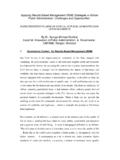Transcription of Child protection, social work and the media: doing …
1 Research, Policy and Planning (2012) 29(2), 83-94. Child protection , social work and the media: doing as well as being done to Ray Jones Kingston University and St. George's, University of London _____. Abstract 2008-2010 was an exceptional time of considerable media coverage of Child protection and social work in the United Kingdom, much of it negative, and some of it personally targeted on individual social workers. The cluster of media stories included the deaths of Baby Peter Connelly' and Khyra Ishaq, the kidnapping of Shannon Matthews, and the extreme assaults on two young boys in Edlington, Doncaster. But as shown in this paper, based on the author's personal engagement with the media, the clustering of stories also gave the opportunity to seek to shape the media and editorial coverage and to explain the realities and complexities of seeking to protect children and of social work .
2 Keywords: social work , Child protection , media Child protection is not an activity undertaken how the media may construct and disseminate in a vacuum. It is heavily influenced by accounts of social work , the paper reflects on contemporary contexts. These contexts the author's experience of seeking to include the experiences of families, which influence this media construction and public may create a platform for more or less telling of social work . adequate parenting; the availability and efficacy of support and assistance for all Being done to families, and especially for families in difficulty; the context of service stability or instability; and the context of public The view often taken within social work in perceptions of children's services, and the United Kingdom, which was emphasised especially services to protect children, which in a recent survey of social workers are heavily influenced by media coverage and (Community Care, 2009), is that the media commentary.
3 The media coverage may even treats social work and social workers unfairly, in part have an impact in changing the focusing on what are deemed to be failures or discourse for Child protection (Parton, 2011). injustices created by social workers and only reporting bad news. The negative distilling, It is this context of the media on which this defining and distorting role of the media has paper focuses. It is a media context which been noted by Stanley and Manthorpe in their reflects an absence of trust and faith, and review of inquiries as the media will sometimes a hostility towards, professionals continue to emphasise the human drama and (O'Neill, 2002; Seldon, 2009). Whilst bad news' aspects of inquiries since these reflecting on the media coverage of Child contribute to news value' (Stanley &.)
4 protection and social work , much of it Manthorpe, 2004, ; see also Butler &. negative, this paper, however, also suggests Drakeford, 2003). This skewed portrayal of and illustrates how the coverage may in part social work and social workers by the general be reshaped, changing as a consequence some local, regional and national media, as of the context for Child protection . compared to the specialist professional press, has both an evidence-base (Galilee, 2006; see The paper is based not on research but on also Glasgow University Media Group, 1976;. personal experience. As well as describing Aldridge, 1990; Aldridge, 1994; Franklin &. Research, Policy and Planning Vol. 29 No. 2 social Services Research Group 2012 all rights reserved 84 Ray Jones Parton, 1991; Franklin, 1999; Ayre, 2001; (although the requirement that Serious Case Ayre & Calder, 2010) and contemporary Reviews, albeit redacted, be published in full affirmation, with comments on the sustained has made this much more difficult).
5 social nature of the negative media images of social workers themselves also may not want the work that have been commonplace' (Munro, exposure which follows personal professional 2011b, ; see also Braun & Robb, 2010; media coverage. Nor may their employing social work Task Force, 2010). agencies welcome the attention which can follow media engagement. When reporters and editors who produce this negative coverage speak about their The consequence of this general reluctance to motivation it is not about selling papers but engage with the media has been to leave about taking the moral high ground. For social workers' stories untold and the example, at a round table' seminar about the damning portrayal of social work media, Child protection and social work held unchallenged.
6 There are, however, social in December 2010 by the School of Law at workers and their agencies who have been the University of the West of England there proactive in describing what they do, the were presentations by a deputy news editor of contribution they make, and the dilemmas the Daily Telegraph, by an independent and difficulties they experience. For example, journalist who sells stories to newspapers and Bristol City Council and its social workers magazines, and by a senior lecturer in and social Services Director agreed to the journalism. Each told of their roles in making of a series of television documentary exposing abuse in children's homes and by fly-on-the-wall' programmes, Someone to social workers, and the deputy editor Watch Over Me' (BBC, 2004), which described how he had reported about parents depicted the work of social workers and the who had had their children unjustifiably lives of the children and families they taken away for adoption by social workers , assisted.
7 It was noted that: with no concern for accuracy in commenting Hopefully the programmes will open up an that social workers had the power to take area of debate and discussion based on the children away' and to have children adopted real working lives of Child care social when there is a legal and judicial process workers. The programmes are intended to which determines these actions. It was also be a remedy to the florid or weak noteworthy that these journalists chose to tell representations of social workers only about stories of abuse by social workers occasionally found on TV soaps like The and care workers, and where they took the Bill' or Eastenders'. The series should moral high ground of exposing this abuse. also challenge other popular stereotypes of social workers.
8 In the main Child care doing as well as being done to social workers are neither inept nor politically correct busy bodies. (Fraser, social workers and their agencies and 2004). managers have been taken to task for their reluctance to engage with the media and More recently Coventry City Council allowed encouraged to engage more (Lombard, 2009; filming over six months which was then Maier, 2009; Munro, 2011a). This reluctance edited into a BBC Panorama Special called may not be surprising when the expectation is Kids in Care' (BBC, 2010) with positive of negative and harassing reporting and review comments about social work (Brody, exposure. There are also ethical and practical 2010; Mangan, 2010). In 2011 Coventry dilemmas for social workers and their Council again allowed the BBC to film a agencies in telling about their work whether programme about children, families, social this is proactively or reactively.
9 Difficulties workers and adoption and in 2012 there was include protecting the interests of service the three-part BBC television series on social users by guarding confidential information work and Child protection in Bristol (see, for Child protection , social work and the media 85. example, Hudson, 2012). The willingness of 1973 that there was the first large scale media Coventry and Bristol Councils to have repeat coverage of a Child protection tragedy in the engagement with the media suggests that the UK and the subsequent inquiry (Department experience can be positive and challenge the of Health and social Security, 1974;. often one-dimensional, simplifying portrayal Community Care, 1974; Butler & Drakeford, of the social work task. 2011). Maria Colwell was aged 7 when she was killed by her stepfather.
10 Since that time Individual social workers (Anonymous, 2008; there have been regular and increasingly Ferguson, 2008; Jones, S., 2008; McKitterick, frequent media stories about the non- 2008) also have a role and contribution to accidental death of children (Hopkins, 2007), make in telling of their experiences and their but usually with a time space between each contribution, and social workers have been story. proactive in seeking that the voice of social workers be heard (Taylor, 2009). However, as However, 2008-2010 has had an exceptional noted by Munro: cluster of media stories about Child abuse It is understood that fear of negative with the focus on social workers and their coverage can cause reluctance in some presumed failings. It has been argued that the media coverage has undermined the workers and their employers to share even positive information.







